Key Takeaways
- Immunotherapy harnesses the body’s own immune system to target cancer cells, offering durable responses for many patients.
- Three main categories dominate the field: checkpoint inhibitors, CART‑cell therapy, and monoclonal antibodies.
- Biomarker testing and understanding the tumor microenvironment are crucial for selecting the most effective therapy.
- Side‑effects differ from chemotherapy; early detection and multidisciplinary management improve outcomes.
- 2024‑2025 saw five new cancer immunotherapy approvals, expanding options for solid tumors and hematologic cancers.
When you hear the word "immunotherapy," you might picture a futuristic vaccine or a lab‑grown virus. In reality, it’s a collection of treatments that teach the immune system to recognize and destroy cancer. Over the past decade, these therapies have shifted from experimental to standard‑of‑care for melanoma, lung cancer, certain lymphomas, and more. This article breaks down how they work, which patients benefit most, and what recent approvals mean for everyday practice.
What Immunotherapy Is and How It Works
Immunotherapy is a treatment approach that stimulates or restores the immune system’s ability to fight cancer cells. Unlike traditional chemotherapy, which directly attacks rapidly dividing cells, immunotherapy pulls the body's own defenses into the fight.
Cancer evades immune detection through several tricks: it hides antigens, creates an immunosuppressive micro‑environment, and exploits checkpoints that tell T‑cells to stand down. Immunotherapy reverses these tricks by either blocking the brakes (checkpoint inhibitors), adding new soldiers (CART cells), or delivering targeted weapons (monoclonal antibodies).
Main Types of Cancer Immunotherapy
Today the field clusters into three clinically proven families. Each has a distinct mechanism, administration route, and disease focus.
Checkpoint Inhibitors
Checkpoint inhibitors are antibodies that block proteins such as PD‑1, PD‑L1, or CTLA‑4, which normally act as brakes on T‑cells. When these brakes are released, T‑cells can recognize and kill tumor cells. Drugs like pembrolizumab (PD‑1) and ipilimumab (CTLA‑4) have become first‑line options for melanoma, non‑small cell lung cancer (NSCLC), and renal cell carcinoma.
CAR T‑Cell Therapy
CAR T‑cell therapy involves extracting a patient’s T‑cells, genetically engineering them to express a chimeric antigen receptor (CAR) that targets a tumor‑specific protein, and reinfusing them. The most common targets are CD19 for B‑cell malignancies and BCMA for multiple myeloma. The result is often a dramatic, rapid remission, though cytokine release syndrome (CRS) remains a management challenge.
Monoclonal Antibodies
Monoclonal antibodies bind directly to antigens on cancer cells, flagging them for immune attack or delivering cytotoxic payloads. Examples include trastuzumab for HER2‑positive breast cancer and rituximab for CD20‑positive lymphomas. Some are conjugated to chemotherapy agents (antibody‑drug conjugates) to increase potency while sparing normal tissue.
| Feature | Checkpoint Inhibitors | CAR T‑Cell Therapy | Monoclonal Antibodies |
|---|---|---|---|
| Mechanism | Blocks inhibitory receptors (PD‑1, PD‑L1, CTLA‑4) | Engineered T‑cells express tumor‑specific CAR | Bind surface antigens; may carry drug payload |
| Typical Administration | IV infusion every 2-3 weeks | Leukapheresis → gene‑edit → infusion (single or split dose) | IV infusion; schedule varies by agent |
| Approved Indications (US, 2025) | Melanoma, NSCLC, RCC, Hodgkin lymphoma, bladder cancer, MSI‑high tumors | B‑cell ALL, DLBCL, mantle‑cell lymphoma, multiple myeloma | HER2‑positive breast, CD20 B‑cell lymphomas, EGFR‑mutant NSCLC (ADC) |
| Key Toxicities | Immune‑related adverse events (colitis, pneumonitis) | Cytokine release syndrome, neurotoxicity | Infusion reactions, cardiotoxicity (some ADCs) |
| Biomarker Requirement | PD‑L1 expression, MSI‑high, TMB‑high | Target antigen (e.g., CD19, BCMA) confirmed | Target antigen over‑expression (e.g., HER2) |
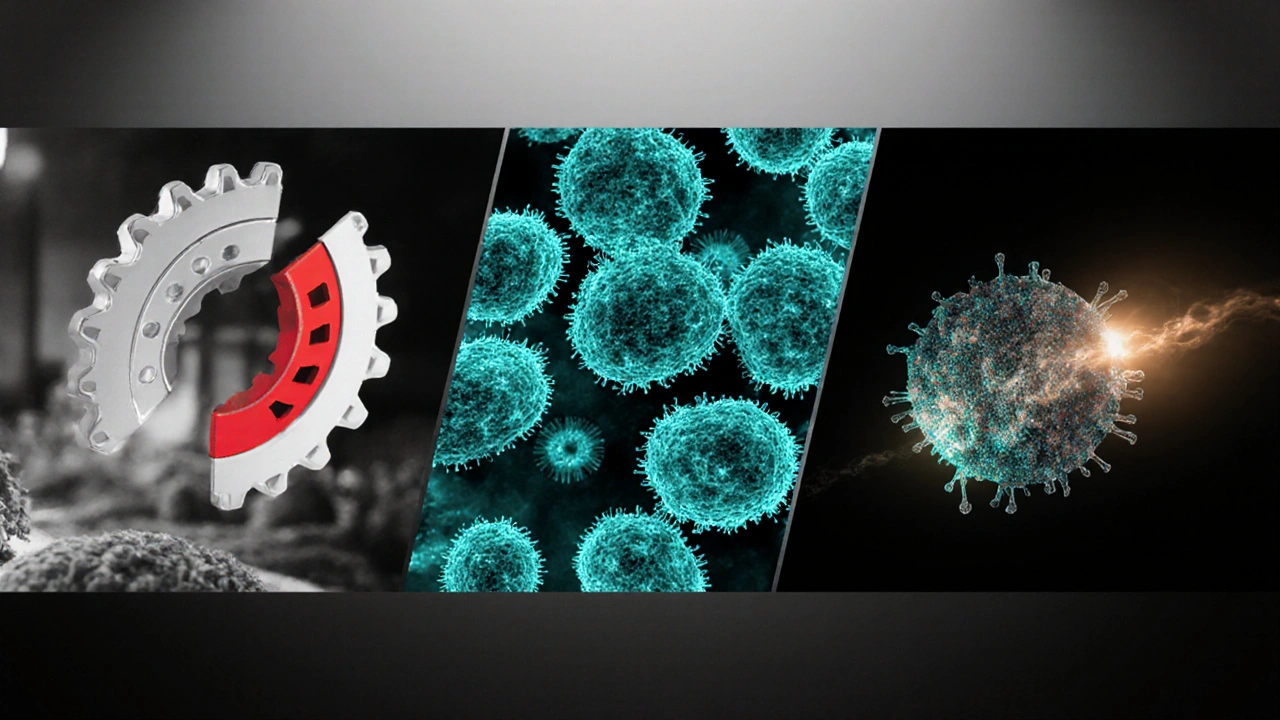
Biomarkers and the Tumor Microenvironment: Picking the Right Therapy
Not every patient benefits from every immunotherapy. The tumor microenvironment (TME) - a mix of immune cells, blood vessels, and signaling molecules - dictates how well a therapy will work.
Tumor microenvironment can be "hot" (inflamed, many T‑cells) or "cold" (immune‑desert). Hot tumors often respond to checkpoint inhibitors, while cold tumors may need combination approaches that first prime the immune system.
Biomarkers such as PD‑L1 IHC score, microsatellite instability‑high (MSI‑H), tumor mutational burden (TMB), and specific antigen expression guide therapy choice. For CAR T, confirming CD19 or BCMA positivity is mandatory; for monoclonal antibodies, HER2 IHC 3+ is the benchmark.
Emerging assays (e.g., gene expression signatures that predict T‑cell infiltration) are increasingly used in multidisciplinary tumor boards. The practical tip: always order a comprehensive immunoprofile before committing to a single immunotherapy.
Managing Unique Side Effects
Immunotherapy side effects differ from chemo‑induced nausea or alopecia. They are called immune‑related adverse events (irAEs) and can affect any organ system.
Common irAEs include colitis, dermatitis, hepatitis, endocrinopathies (hypophysitis, thyroiditis), and pneumonitis. Early detection hinges on patient education: prompt reporting of new diarrhea, shortness of breath, or rash can prevent severe complications.
Cytokine release syndrome (CRS) is the headline concern for CAR T. Grading follows the Lee criteria, and treatment ranges from supportive care to tocilizumab (IL‑6 blockade) and steroids. Neurotoxicity (ICANS) requires neurologic monitoring and sometimes high‑dose steroids.
Multidisciplinary management-oncology, gastroenterology, pulmonology, endocrinology-has become the standard of care. Institutions now run dedicated irAE clinics that reduce hospitalization rates by up to 30%.
Recent FDA Approvals and Clinical Trial Landscape (2024‑2025)
2024‑2025 was a big year for immunotherapy. The FDA granted five new approvals, expanding the arsenal for solid tumors.
- Penpulimab - a PD‑1 inhibitor for locally advanced esophageal squamous cell carcinoma.
- Lisocabtagene maraleucel (liso‑cel) - a second‑generation CD19 CAR T approved for relapsed/refractory follicular lymphoma.
- Tarlatamab - a bispecific antibody targeting DLL3 in small‑cell lung cancer, shown to improve median OS to 12.4 months.
- Trastuzumab deruxtecan - an antibody‑drug conjugate for HER2‑low breast cancer, achieving a 38% response rate.
- Relatlimab + nivolumab - first‑line combo for melanoma showing 5‑year survival > 55%.
FDA approval trends show a shift toward combination regimens (checkpoint + anti‑angiogenic, or checkpoint + targeted therapy) and toward earlier‑line use. Ongoing phase III trials (e.g., KEYNOTE‑716, CANCER‑001) are testing checkpoint inhibitors in adjuvant settings for breast and prostate cancer, respectively.
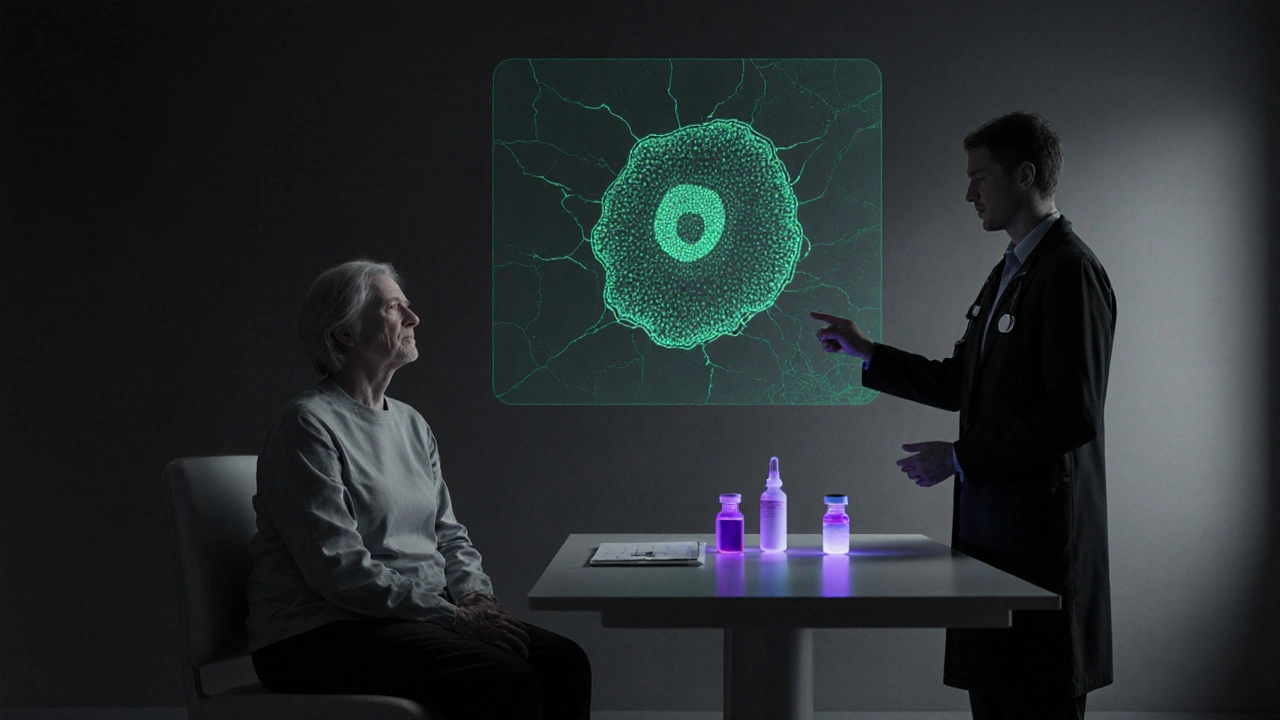
Practical Tips for Patients and Clinicians
For patients:
- Get a full immunoprofile (PD‑L1, MSI, TMB, antigen expression) before starting therapy.
- Keep a daily symptom diary; even mild rash or joint pain can signal an irAE.
- Maintain a balanced diet and stay active-studies link healthier lifestyles with better immunotherapy responses.
For clinicians:
- Integrate oncology, pathology, and radiology data into a unified dashboard to track biomarker trends.
- Adopt prophylactic steroid tapering protocols for high‑risk checkpoint regimens (e.g., ipilimumab + nivolumab).
- Enroll eligible patients in clinical trials; the 2025 trial enrollment rate for immunotherapy in major US centers exceeds 40%.
Future Outlook
The next wave will likely blend immunotherapy with personalized neoantigen vaccines and oncolytic viruses, creating a triple‑hit approach: prime the immune system, target the tumor, and sustain the attack. Artificial intelligence is already helping to predict which neoantigens will be most immunogenic, accelerating vaccine design.
As the field matures, cost‑effectiveness analyses are showing that durable responses can offset the high upfront price of agents like CAR T, especially when patients stay progression‑free for years. Payers are beginning to adopt outcome‑based contracts, tying reimbursement to real‑world survival data.
Frequently Asked Questions
What types of cancer can be treated with immunotherapy?
Immunotherapy is approved for melanoma, non‑small cell lung cancer, renal cell carcinoma, Hodgkin lymphoma, bladder cancer, head and neck cancers, certain breast cancers (HER2‑low), multiple myeloma, and several hematologic malignancies. Ongoing trials are expanding the list to prostate, pancreatic, and colorectal cancers with specific biomarkers.
How do checkpoint inhibitors differ from CAR T‑cell therapy?
Checkpoint inhibitors are off‑the‑shelf antibodies that block proteins like PD‑1 or CTLA‑4, allowing existing T‑cells to act. CAR T‑cell therapy is a personalized product: a patient’s T‑cells are extracted, genetically modified, and reinfused. Checkpoint inhibitors are given repeatedly by IV; CAR T is usually a one‑time infusion after a manufacturing period.
What are the most common side effects of immunotherapy?
Immune‑related adverse events such as colitis, dermatitis, hepatitis, pneumonitis, and endocrine disorders are typical for checkpoint inhibitors. CAR T‑cell therapy commonly causes cytokine release syndrome and neurotoxicity. Early detection and steroid management are key to minimizing severity.
Do I need biomarker testing before starting immunotherapy?
Yes. Tests for PD‑L1 expression, MSI‑high status, tumor mutational burden, and specific antigen presence (e.g., HER2, CD19) guide therapy selection and predict response. Most oncology centers now run a comprehensive immunoprofile as part of the initial work‑up.
How quickly do CAR T‑cell therapies work?
Responses can be dramatic, often within weeks after infusion. In B‑cell ALL, complete remission rates exceed 80% within 30 days. However, monitoring for CRS and neurotoxicity is critical during this early period.

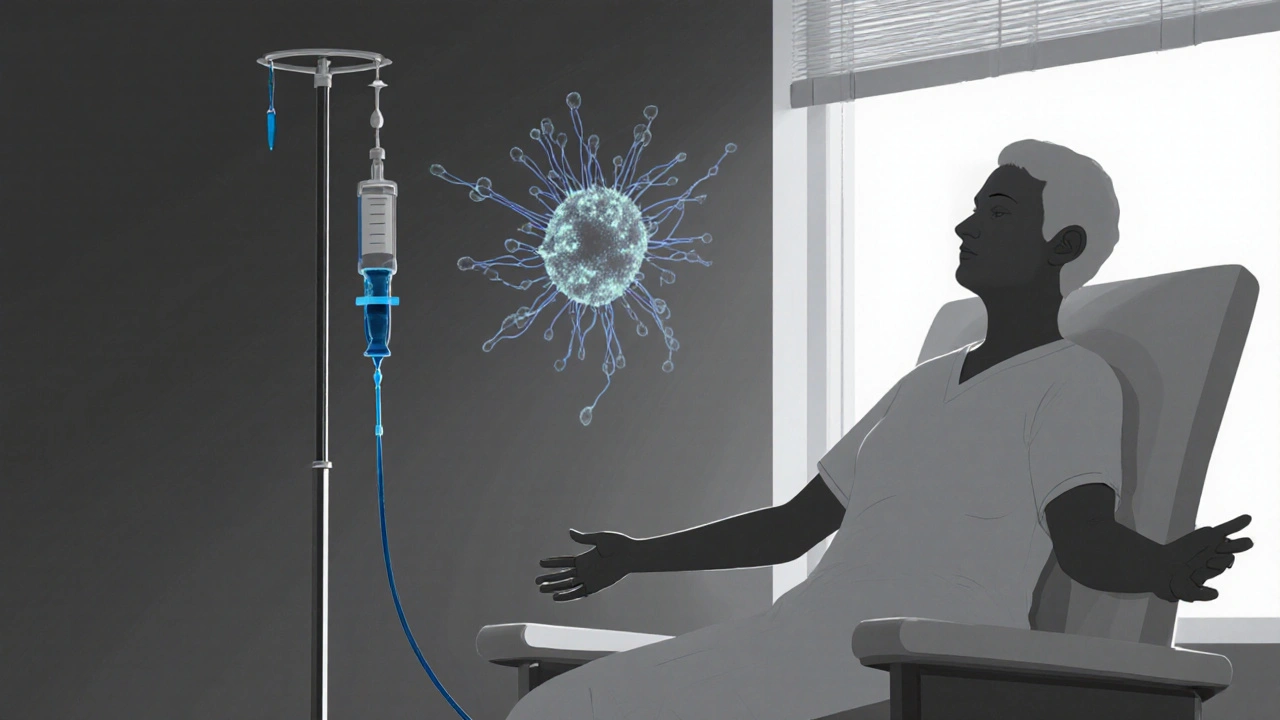
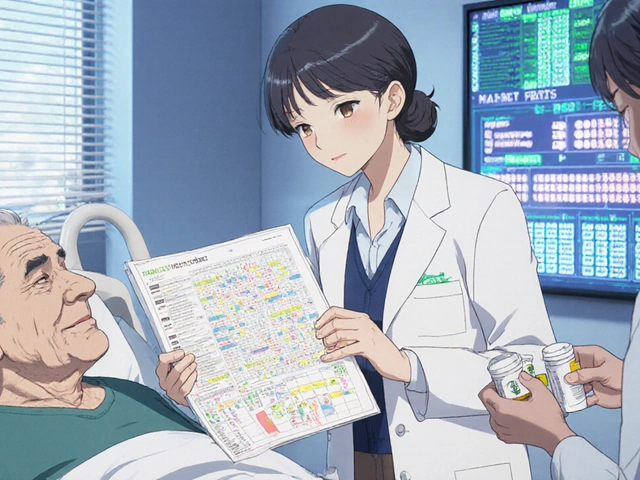

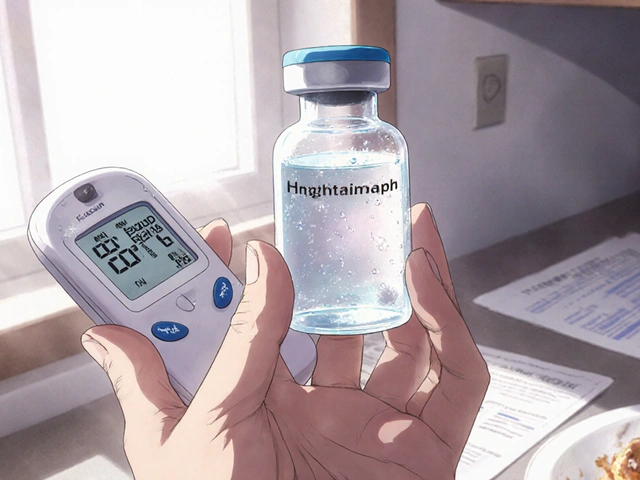


16 Comments
Immunotherapy really changed the game for a lot of patients.
Getting the full immunoprofile before starting therapy is essential. It guides you toward the checkpoint inhibitors or CAR‑T that will actually work, and it spares you from unnecessary side effects. The more data you have, the smoother the treatment journey.
Isn't it fascinating how we keep chasing the same immune checkpoints, yet each patient’s tumor tells a different story? Sometimes I wonder if the hype outpaces the real, incremental progress. Still, the hope it brings keeps the conversation alive.
From a patient‑centered view, the shift toward early‑line immunotherapy feels like a breath of fresh air. When clinicians order a comprehensive panel, they’re not just checking boxes; they’re tailoring therapy to an individual’s tumor microenvironment. Hot tumors often light up with checkpoint inhibitors, whereas cold ones may need a priming combo. It’s also encouraging that irAE clinics are popping up, reducing hospital stays. Overall, the ecosystem is becoming more proactive rather than reactive.
Oncologists should integrate pathology, radiology, and molecular data into a single dashboard. This unified view streamlines decision‑making and helps identify patients who meet biomarker thresholds for approved agents. Prophylactic steroid tapers, especially for ipilimumab‑containing regimens, can further mitigate immune‑related toxicity. Moreover, enrolling eligible patients in ongoing trials sustains progress and expands therapeutic horizons.
The emergence of bispecifics like tarlatamab illustrates the escalating complexity of immuno‑oncology. While efficacy signals are promising, the pharmacodynamic profile demands rigorous monitoring. Clinicians must balance the allure of novel mechanisms against the practicality of managing multilayered adverse events.
Oh great, another “breakthrough” that will cost a fortune and only a handful will actually live longer.
Wow!! This field is exploding!!! So many new drugs!!! I can’t keep up with the names-pembrolizumab, liso‑cel, tarlatamab-each one feels like a sci‑fi weapon!!! But seriously, the pace is insane and patients are finally getting hope!!!
While enthusiasm is warranted, one must scrutinize the data behind each approval. The Phase III trials for penpulimab, for instance, reported a modest OS benefit that may not translate outside trial settings 📊. Moreover, cost‑effectiveness analyses remain inconclusive, necessitating judicious adoption 🤔.
I totally agree with the need for critical appraisal-especially when the headline numbers look shiny. Still, real‑world evidence is starting to show that these agents can become cost‑effective over time. Let’s keep sharing outcomes so everyone benefits.
In the Indian context, access to CAR‑T is still limited, but collaborations with global centers are bridging the gap. We should also consider cultural factors when counseling patients about possible irAEs. Education empowers patients to report symptoms early.
It’s great to see the community discussing practical steps for biomarker testing.
But the conversation often forgets the underlying biology these markers represent it’s not just a checkbox
The recent surge in immunotherapy approvals is undeniably impressive, yet it also raises a host of systemic concerns that cannot be ignored. First, the financial burden on the healthcare system escalates dramatically as each novel checkpoint inhibitor or CAR‑T product carries a six‑figure price tag. Second, the infrastructure required to safely administer and monitor these therapies-specialized infusion suites, irAE clinics, and trained multidisciplinary teams-is lacking in many regions. Third, the reliance on biomarkers such as PD‑L1 expression creates disparities, because not all laboratories can perform standardized testing. Fourth, the commercial pressure to adopt these agents early often outpaces the accumulation of long‑term safety data. Fifth, patients are sometimes rushed into treatment without a full discussion of potential quality‑of‑life impacts. Sixth, the hype surrounding “personalized” vaccines can distract from the proven benefit of existing checkpoint inhibitors. Seventh, regulatory pathways that expedite approvals may inadvertently lower the evidentiary bar. Eighth, insurance reimbursement models still lag behind, resulting in coverage denials that leave patients in limbo. Ninth, the global inequity is stark, as low‑income countries struggle to afford even the older immunotherapies. Tenth, the environmental footprint of manufacturing complex biologics is an overlooked issue. Eleventh, clinicians must stay up‑to‑date with an ever‑expanding literature, a task that can lead to burnout. Twelfth, academic institutions are pressured to produce data quickly, sometimes at the expense of methodological rigor. Thirteenth, the narrative that immunotherapy is a panacea can undermine necessary lifestyle interventions that also improve outcomes. Finally, while the promise is real, we must balance optimism with prudent stewardship to ensure that these breakthroughs benefit all patients rather than a privileged few.
Thanks for the balanced take! 😊 Sharing these insights helps everyone stay informed.
Another pricey drug, same old story.
Write a comment